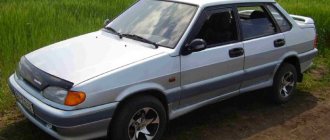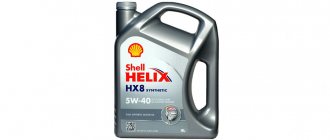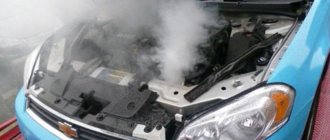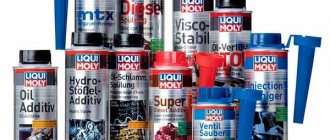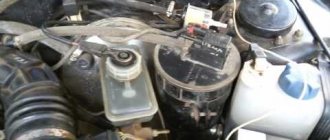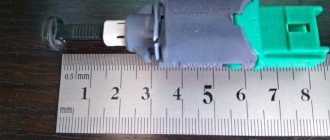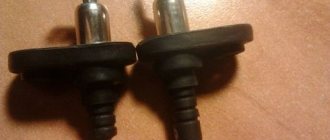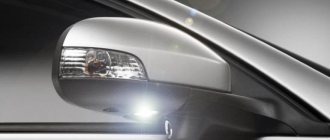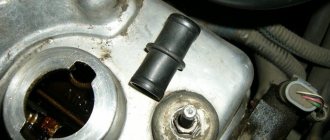| Year | Engine | Type | Color | Lifetime | Recommended Manufacturers |
| 1987 | for all | TL | blue | 2 years | Felix, Prompek, Speedol Super Antifreez, Sapfire, Antifreeze-40 |
| 1988 | for all | TL | blue | 2 years | Lukoil Super A-40, AGA-L40, Sapfire, Antifreeze-40 |
| 1989 | for all | TL | blue | 2 years | Alaska A-40M, AGA-L40, Sapfire |
| 1990 | for all | TL | blue | 2 years | Felix, AGA-L40, Speedol Super Antifreeze, Sapfire |
| 1991 | for all | TL | blue | 2 years | Lukoil Super A-40, Tosol-40, Speedol Super Antifriz, Sapfire |
| 1992 | for all | TL | blue | 2 years | Antifreeze-40, AGA-L40, Speedol Super Antifriz, Anticongelante Gonher HD |
| 1993 | for all | G11 | green | 3 years | Glysantin G 48, Lukoil Extra, Aral Extra, Mobil Extra, Zerex G, EVOX Extra, Genantin Super |
| 1994 | for all | G11 | green | 3 years | Lukoil Extra, Zerex G, Castrol NF, AWM, GlycoShell, Genantin Super |
| 1995 | for all | G11 | green | 3 years | Glysantin G 48, Havoline AFC, Nalcool NF 48, Zerex G |
| 1996 | for all | G11 | green | 3 years | Mobil Extra, Aral Extra, Nalcool NF 48, Lukoil Extra, Castrol NF, GlycoShell |
| 1997 | for all | G11 | green | 3 years | AWM, EVOX Extra, GlycoShell, Mobil Extra |
| 1998 | for all | G11 | green | 3 years | Havoline AFC, Aral Extra, Mobil Extra, Castrol NF, AWM |
| 1999 | for all | G11 | green | 3 years | Aral Extra, Genantin Super, G-Energy NF |
| 2000 | for all | G12 | red | 5 years | GlasElf, AWM, MOTUL Ultra, G-Energy, Freecor |
| 2001 | for all | G12 | red | 5 years | Castrol SF, G-Energy, Freecor, Lukoil Ultra, GlasElf |
| 2002 | for all | G12 | red | 5 years | Freecor, AWM, MOTUL Ultra, Lukoil Ultra |
| 2003 | for all | G12 | red | 5 years | Lukoil Ultra, Motorcraft, Chevron, AWM |
| 2004 | for all | G12 | red | 5 years | MOTUL Ultra, MOTUL Ultra, G-Energy |
| 2005 | for all | G12+ | red | 5 years | Chevron, AWM, G-Energy, Lukoil Ultra, GlasElf |
| 2006 | for all | G12+ | red | 5 years | Chevron, G-Energy, Freecor |
For diesel and gasoline engines the parameters will be the same!
When purchasing, you need to know the shade - Color and Type of antifreeze allowed for the year of manufacture of your 2109. Select the manufacturer at your discretion. Do not forget - each type of liquid has its own service life.
For VAZ 2109 (1st generation) 1987, with any type of engine, the traditional class of antifreeze, type TL or antifreeze with shades of blue is suitable. The approximate period of the next replacement will be 2 years.
If possible, check the selected fluid against the vehicle manufacturer's specifications and service intervals.
Each type of liquid has its own color. There are rare cases when the type is tinted with a different color. The color of red antifreeze can be from purple to light pink (green and yellow have the same principles).
What is antifreeze for?
During engine operation, a lot of heat is generated, which must be removed and released into the atmosphere through the radiator. Inside the engine there are channels through which the coolant (coolant) moves, collecting excess thermal energy and delivering it to the radiator. At the same time, it is constantly in contact with engine and cooling system parts made of various materials, and therefore must be chemically inert towards them.
Choosing antifreeze for VAZ
In winter, when the air temperature drops below zero degrees, water, which is the main component of any antifreeze, must turn into solid form, that is, turn into ice. However, other components of antifreeze prevent this development of events, so the freezing point of the coolant is much lower than that of water. Even when the temperature drops below the permissible level, antifreeze does not turn into a solid piece of ice, tearing the engine apart from the inside, but into many small balls, which protects the engine from damage.
Competent choice of high-quality antifreeze for VAZ 21099
Hello! The car is a VAZ 21099, it was filled with Felix blue. Please tell me whether it is worth changing to red or green (if this is permissible)? (Victor)
Good afternoon, Victor. The issue of choosing consumables should always be approached with special responsibility. Therefore, you did the right thing by turning to us for advice. We have analyzed your question and are ready to make some recommendations.
Main characteristics of antifreeze
The main characteristics include:
- boiling point;
- freezing temperature;
- a class that determines the composition and physicochemical properties.
Boiling point
The operating temperature of engines installed in front-wheel drive VAZ cars is 90–100 degrees, but a short-term increase to 103 degrees is acceptable. Therefore, the boiling point of the coolant should be at least slightly higher than the maximum permissible engine temperature, that is, be above 105 degrees. If the car is used to transport a trailer along mountain roads, or for various races, then the boiling point of the coolant should be at least 110 degrees, because the engine works in heavy duty and gets very hot.
Freezing point
The freezing or crystallization temperature of the coolant should be below the expected minimum (nighttime) temperature in winter. If the coolant parameter is higher, then despite crystallization in the form of balls, engine damage may occur.
Antifreeze class
Antifreeze class shows:
- its chemical composition;
- physical and chemical effect on engine parts and cooling system;
- life time.
Replacing antifreeze VAZ
This parameter is marked with the letter “G” and numbers that indicate the class of the coolant, as well as the content of certain reagents in it that affect its physical and chemical properties. The basis of any antifreeze poured into the cooling system is water, antifreeze is provided by ethylene glycol, propylene glycol or glycerin, and various additives, so-called corrosion inhibitors, which determine the class of the product, protect the engine from the effects of coolant. Here are the classes of antifreeze:
- G11 is an ethylene glycol-based antifreeze; silicates and salts of various inorganic acids are used as corrosion inhibitors. This coolant has low thermal conductivity, because silicates form thick scale on the channel walls, which impairs the heat transfer from metal parts. The service life of such a substance is 1–2 years, after which the effectiveness of the inhibitors decreases and the antifreeze begins to destroy the engine. Antifreeze developed in the USSR belongs to the same class.
- G12 is a coolant based on ethylene glycol, and salts of aliphatic carboxylic acids (carboxylates) are used as corrosion inhibitors, which interact with the metal only in areas of corrosion. Due to the absence of a thick layer of scale, the liquid removes heat more efficiently, and the service life is 5–7 years.
- G12+ is an ethylene glycol-based antifreeze, and silicates and carboxylates are used as corrosion inhibitors in various proportions, thereby combining relatively low cost, efficiency and a long (4-6 years) service life. Some manufacturers call this antifreeze hybrid.
- G12++ is a substance based on ethylene glycol, contains carboxylates and silicates, but has a high boiling point (135 degrees).
- G13 - antifreeze based on non-toxic propylene or glycerin, corrosion inhibitors - carboxylates and various inorganic elements, including silicates. G12++ is inferior in heat transfer, and its price is noticeably higher.
Required accessories
Maintenance of the engine cooling system is possible with at least 8 liters of special composition. In the service book, Lada specialists display a list of suitable coolants:
- Antifreeze AM;
- "OZHK LENA";
- "LENA-40";
- Antifreeze A-40M;
- SPEKTROL ANTIFREEZE;
- AGIP ANTIFREEZE EXTRA;
- Glisantin G 03.
The accessories are an open-end wrench set to “13”, a screwdriver and a container for draining antifreeze with a volume of at least 8 liters.
Which antifreeze to choose for VAZ 2108–2115 cars
Despite the fact that these machines were equipped with different engines, antifreeze classes G12, G12+ and G12++ are best suited for them. Antifreeze and other G11 class coolants can be poured into a car only if you are ready to change it every two years and will operate the vehicle without heavy loads (gentle mode).
G13 class material does not provide the same heat transfer as previous classes of fluids, so it does not offer any safety benefits. Therefore, the answer to the question - what kind of antifreeze to pour into a VAZ 2114 car depends on the goals that the owner sets for his vehicle.
Remember: color has nothing to do with the class of antifreeze, so for some manufacturers red liquid is classified as G12+, while for others it may even be assigned G13 or G11. Therefore, look at what is written on the coolant container and indicated in the certificate of conformity.
How is coolant classified?
If you use the original blue antifreeze, then you provide the system with reliable protection from rust and foam. This liquid also comes in a yellow color, but it is completely unsuitable for our car; it is intended for heavy-duty engines. The green solution is particularly resistant to corrosion and has a high level of thermal conductivity. Therefore, this product will also suit you. If you are looking for a coolant that will last you as long as possible, then pay attention to the red fluid. It can not be changed for five years.
Change or top up after a cooling system leak
This question arises when a car owner or driver discovers a puddle of antifreeze under a VAZ 2114 or any other car. It is not difficult to distinguish spilled antifreeze from oil or gasoline - just touch it with your fingers and rub them together; oil distillation products will leave greasy marks on the skin. If you are not sure whether it is air conditioner or coolant condensation that is spilled under the car, touch the liquid with your finger or a rag, then look at its color - the condensation is distilled water and is therefore colorless.
Remember: the cooling system is sealed, so the coolant leaves it only if the integrity of the engine or other parts is damaged. If antifreeze is in the cabin of a car (VAZ 2115), or is spilled under it, then its cooling system needs urgent repairs. Only after it has been restored can new fluid be added.
But when this happens while driving, you cannot do without adding fluid. And here the question arises, what kind of antifreeze to pour into a VAZ 2114 car (or any other) in order to avoid troubles. Well, if the class of antifreeze in the cooling system is known, then it is enough to purchase the same liquid at the nearest gas station or auto store.
If the coolant class is unknown, then fill in G12+ antifreeze, because it is more compatible with substances of other classes. But you can’t drive with such a mixture for a long time, because the products of different classes conflict with each other, which negatively affects the condition and service life of the engine. That is, you can drive to the repair site, and after fixing the problem, you need to flush the cooling system and fill it with a fluid of a suitable class.
Replacing antifreeze on a VAZ
If you suspect that the cooling system is filled with G11 liquid, then you can mix antifreeze with antifreeze in the cooling system of a VAZ 2110 or any other car only in the most urgent cases, in order to drive under your own power to the repair site.
In addition, after eliminating the leak in the cooling system, it is necessary to dry the car interior from antifreeze VAZ 2114 or any other model/brand.
Fluid replacement
If you plan to switch the car from antifreeze to antifreeze for any reason, then the old coolant should be drained by unscrewing the plugs in the block and in the radiator. It is worth remembering that this will not help remove the entire volume of coolant (and it is consistently equal to 7.8 liters).
In order to completely clean the entire system, you should fill it with ordinary water and drive the car for about 30 kilometers, after which you should drain everything again and add antifreeze. It goes without saying that this procedure can only be carried out in the warm season, but not in the cold.
It should be said right away that some motorists perform themselves and advise others to carry out additional procedures for cleaning the system of old coolant - adding vinegar, acetone and other additives to distilled water. It is strictly not recommended to carry out such operations. At best, they will be of no use; at worst, they can cause damage to the cooling system.
Change or add antifreeze after the engine boils
If antifreeze boils in a VAZ 2114 or any other model, the following happens: water, which is the coolant, evaporates and turns into steam, which raises the pressure in the engine cooling system. This leads to squeezing out some of the liquid into the expansion tank, and after it overflows, onto the ground. Steam has a much lower ability to transmit and transfer heat, so the cylinder head (cylinder head) becomes very hot, which leads to hardening of the valve stem seals, which is why they can no longer hold oil.
In addition, due to a sharp jump in temperature, the head housing is deformed, and the cylinder liners and the upper part of the block overheat. If immediately after boiling the engine was switched to economy mode (2.5–3 thousand rpm without load) in order to increase the circulation of antifreeze residues and cool the cylinder head, then there is a high probability of damage to this part. In especially severe cases, even the cylinder block suffers, that is, the mating plane on the head side is deformed.
How to replace antifreeze VAZ
If the car still boils, and there is no way to call a tow truck, then add any liquid, you can mix antifreeze with antifreeze in the cooling system of a VAZ 2114 or any other car, because after reaching the nearest car service center you will have to change or overhaul the engine. Therefore, it is better to regularly check the condition of the engine and change the coolant in a timely manner, because the cost of repairing or replacing the power unit is tens of thousands of rubles.
Remember: it doesn’t matter whether you add fluid or completely replace it in a boiling engine, this will not eliminate the damage that it has already received, so you cannot do without repairs. If you neglect repairs, then in the best case, oil and gasoline consumption will sharply increase, and the engine power will noticeably drop, and in the worst case, the power unit will catch fire, after which it will be extremely difficult to put out the car.
Why do you need to change the coolant?
It is very important to change antifreeze on time, because the general condition of your four-wheeled friend depends on it. The cooling system must always be in order. Otherwise, more serious problems will begin. Up to the complete cessation of engine operation. From experience I can say that antifreeze needs to be changed as needed. To do this, periodically look under the hood and check the coolant level. It is very important to use only high-quality antifreeze so that no problems will arise.
How to change antifreeze
Do-it-yourself coolant replacement is available to any car owner. If you decide to do it yourself, then do this:
- Park the car on a level surface.
- Jack up the front of the car and secure it with jack stands.
- Remove the engine protection.
- Lower the vehicle to the ground.
- On injection VAZ 2110–2115, disconnect the ignition module from the engine and move it away, because it blocks access to the drain plug of the block.
- Place a basin with a volume of 8–10 liters under the car (hood area).
- Cover the generator with a piece of plastic bottle or a piece of cellophane/polyethylene to protect it from liquid.
- Unscrew the drain plugs on the radiator and cylinder block.
- Unscrew the cap of the expansion tank.
- Wait for the coolant to drain.
- Tighten the drain plugs.
- Reinstall the protection and ignition module.
- Pour antifreeze into the expansion tank in small portions, waiting until it fills the engine and squeezes out the air.
In this video you will see the entire process of replacing the coolant:
If you do not place the basin under the stream of coolant, then when it is drained, a puddle of antifreeze under the VAZ 2114 will definitely appear, and given the toxicity of most coolants, it is undesirable to allow this.
To pour antifreeze into a car without air locks VAZ 2114 (or any other), you need to follow a special procedure.
If the filling is incorrect, there is a high risk of airing the cooling system, that is, some of the cylinder head channels are not filled with coolant, which means that the part will operate under constant overheating. On carburetor models, it is not difficult to remove excess air; to do this, start the engine for 20–40 seconds so that the pump expels the air, and then add the missing fluid.
What to choose?
Today, when replacing coolant in domestically produced cars, antifreeze is most often mentioned. But in addition to antifreeze, antifreeze is also actively used for more modern cars.
In the VAZ 2109 cooling system, you can use antifreeze, not antifreeze.
- All coolants are antifreeze, and antifreeze is a coolant developed back in Soviet times as an alternative to foreign antifreeze;
- Antifreeze is simply the name of a type of antifreeze, more adapted to the specifics of car operation in our country (then USSR);
- The price is more affordable compared to other coolants;
- Most often used by domestic car owners
- There are many types of antifreeze in the world;
- The difference between them is the base, color, composition and other parameters;
- Antifreeze contains special additives that ensure efficient operation of the cooling system and extend its service life;
- Antifreeze solution is more expensive, which is the most common reason for choosing an antifreeze solution.
Variety of assortment
Considering the features of each of the presented types of coolants, certain conclusions can be drawn:
- If we take into account the quality characteristics, then it is much better than antifreeze.
- Antifreeze is more practical when considering its adaptation to our cars. Its composition was developed taking into account the local climate, vehicle quality and road conditions.
- Antifreeze can be asked by any oncoming driver passing by when his VAZ 2109 breaks down.
- The properties of antifreeze are sufficient for the normal functioning of CO.
Practice shows that there is no point in overpaying for antifreeze in order to pour coolant into the VAZ 2109 cooling system.
Equipment
